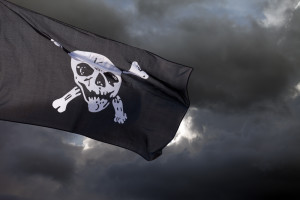
Pull away, me lads o’ the Cardiff Rose
And hoist the Jolly Roger
Roger McGuinn’s song was the pirate song I grew up with. And the Jolly Roger – the skull and crossbones against a black background – still waves supreme over American pirate lore.
So imagine my surprise when I moved to Germany and learned a new pirate shanty, the German folksong Wir lieben die Stürme (We Love the Storms):
Unser Schiff gleitet stolz durch die schäumenden Wellen.
Es strafft der Wind unsre Segel mit Macht.
Seht ihr hoch droben die Fahne sich wenden,
die blutrote Fahne, ihr Seeleut habt acht!
(Our ship slices proudly through fierce churning whitecaps. The wind whips our sails and drives up our speed. Look high aloft how our banner is waving, the blood red banner, you sailors take heed!)
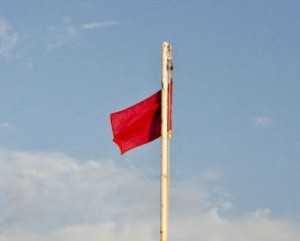
A blood red pirate flag? Really?
Unbelieving, I asked my German husband, who assured me that the pirate flags of German lore are indeed red. Maybe, he suggested, the Jolly Roger is just an Anglo-American invention.
His comment drove me to the history books.
As so often the case, we were both right. Red pirate flags are just as entrenched in pirate history as are black ones. Here are some interesting facts I found:
Black flags

Black pirate flags have an ancient history. Francis Drake, an English privateer, usually flew the flag of St. George, although in 1585, he flew black banners and streamers.
Red flags
Red pirate flags also have a history. In 1681, buccaneers off the islands of Juan Fernández flew a “bloody flag.”
No quarter
Red and black have two different meanings. A French flag book from 1721, containing colored engravings of both black and red pirate flags, labeled the red flag as “flag called no quarter.” Captain Richard Hawkins confirmed this meaning in 1724. His pirate ship flew the black Jolly Roger when he was willing to give quarter and the red banner when he wasn’t.
Jolly Roger
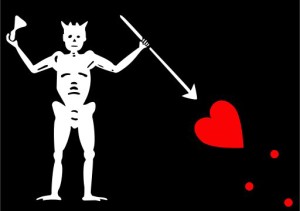
The Jolly Roger doesn’t have to be the skull and crossbones. Captain Richard Hawkins described his “Jolly Roger” as a full skeleton with an hourglass in one hand, indicating limited time, and a dart in the other hand, indicating violence. Other captains flew pirate flags with similar symbols.
Origins of Jolly Roger
The term “Jolly Roger” might have come from the French jolie rouge, or “red flag.” It might also derive from “Old Roger,” which means “devil.”
Skull and Crossbones
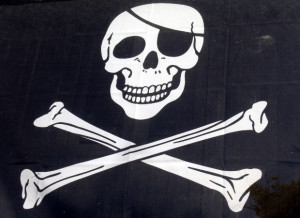
The skull and crossbones became popular among English, French, and Spanish pirates by 1730.
National Colors
A 1684 book, Buccaneers of America, doesn’t mention black flags or skulls at all. English buccaneers in America sailed under English colors.
Red in Santa María
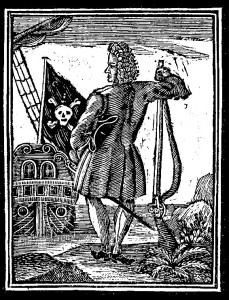
A sailor’s journal described 300 buccaneers marching on the town of Santa María in 1680. The various companies flew pirate flags of pure red, pure green, and red and yellow stripes. Red was the most common color.
Blackbeard and his flags
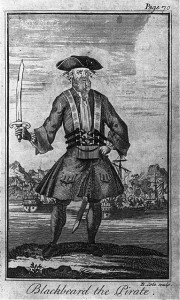
Of Blackbeard’s squadron of five ships in 1718, two flew black flags and three flew red.
Pirate flags in fiction
Both colors appear in English fiction. Daniel Defoe’s description of pirates in his 1720 story Captain Singleton has them flying both black and red flags.
What symbols do you associate with pirates?
Literature on point:
David Cordingly, Under the Black Flag: The Romance and Reality of Life among the Pirates (New York: Random House, 1996, 1st Harvest House ed.) 114-119.

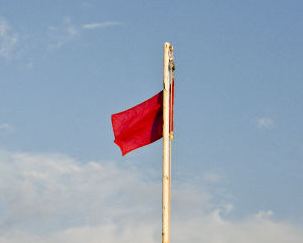

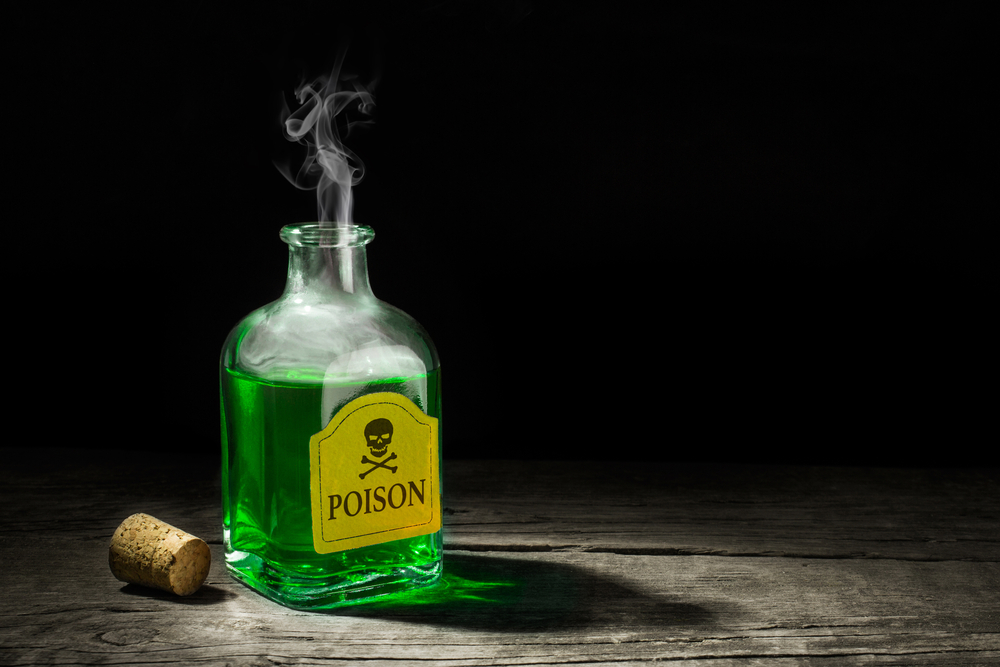

Why do pirates display a flag? to tell ships “don’t mess with us” or “surrender now”? Did a pirate ship put up many different flags – sometimes black, sometimes red – and sometimes non-pirate flags (to trick people)? Could a non-pirate ship put up a pirate flag to scare off a pirate ship?
To scare their prey into a quick surrender. And yes, they sometimes flew national colors to trick their victims into thinking they were merchant ships. That allowed the pirates to approach close enough to prevent the victim’s escape. Then the pirates switched flags to instill terror.
Thus the phrase, “Show your TRUE colors”. Personal pirate flags also became their “calling card” to show or establish their reputation. Some pirates carried both red and black flags. The black flag announced that they were pirates and you should surrender (not to “scare off” a ship). with little loss of life. If the ship attempts to resist or fight back, the RED flag might be hoisted signifying that no life would be spared!
The symbols themselves could also tell much about their specific intent. Bartholomew Roberts’ flag shows him standing on two skulls labeled “ABH” and “AMH” (a Bahaman head and a Martinique head) showing his special disdain for those governments. Christopher Moody’s red flag can be directly read and understood: winged hourglass, raised arm with dagger, death’s head= “your time is running out-it you fight, you will die-we don’t take prisoners”.
I had no idea where the phrase “show your true colors” came from, but that makes total sense! Thanks too, Barnaby, for the more precise information about the symbols. Before the days of radio and telegraph communication, flags and their symbols were the best means for ships to communicate with each other.
The boundary between pirate & privateer was often unclear. They could set sail on legitimate voyage but if was broke out in the meantime they could accidentally be breaking the law. Flags were a means of communication at sea, hence head of squadron was the flagship.
Thanks for pointing that out, Barb. In fact, didn’t Captain Kidd get into trouble by sailing off on a voyage as a privateer, and then the laws changed while he was gone?
I’ve been doing some research for a historical tour I’m running and I came across several books that claim that John Rackham or better known as Calico Jack was known for flying the “original” Jolly Roger and it was a skull and crossed swords.
That is interesting information! Thanks for posting, Michael. Where do you give your tour and where could my readers get more information about it? Who knows? Some of my readers might be interested.
I am Francis Buster Worley Akrey and my Great Grandfather 6 times back was Richard Worley the brass pirate. We Worley’s believe the Jolly Roger is our family flag. If the queen would have paid her bill to us Grandpa would not have gone pirate. But she didn’t so he did and the flag was born, the is ours. I have the tat like the rest of us.
Wow! If the Jolly Roger is your family flag, you sure have quite a legacy! The Jolly Roger is better known than the coat of arms of the British royal family. What was the bill that the queen didn’t pay, and which queen was it? (I’m guessing Victoria if it was six generations back, but Anne would fit better into the age of piracy.)
I’ve put a red crimson pirate flag our side my home for no reason makes me feel like me for some reason is this okay to do or will I have issues with the law ?
I’m not aware of any legal issues but can’t give you legal advice. Check your local ordinance. Otherwise, have fun with your flag.